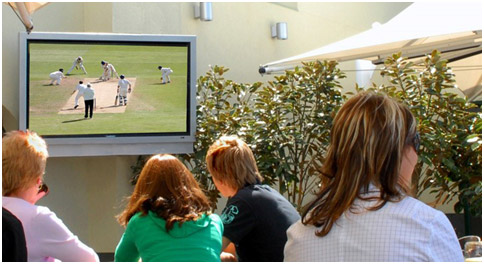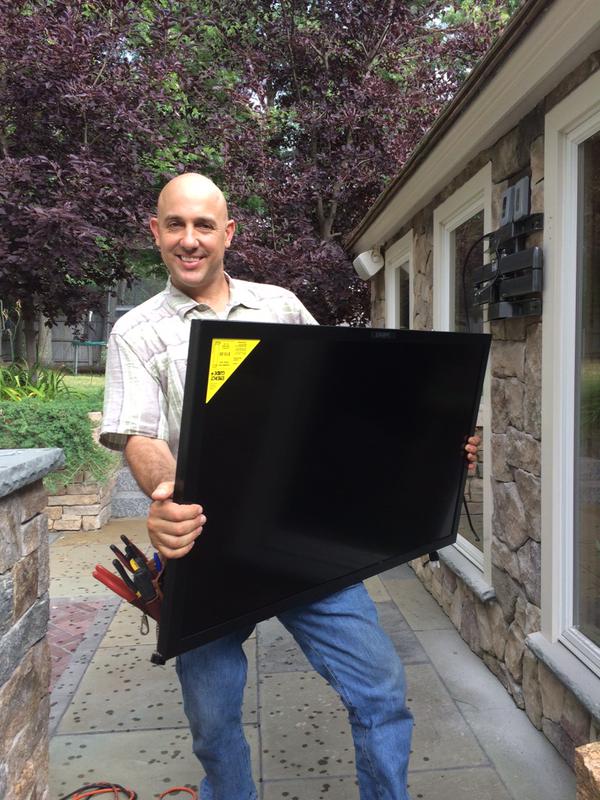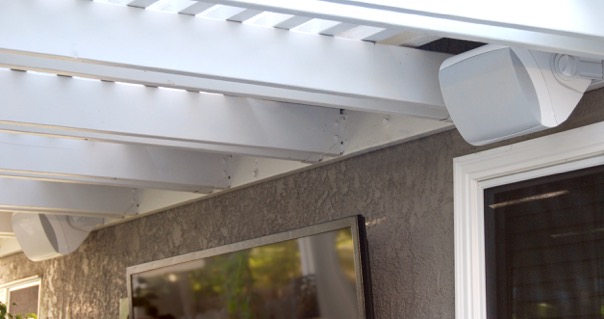How to Pick the Right TV for Your Deck or Patio
Dec 29th 2021
Who doesn’t love getting together on the deck or patio with friends for a backyard barbecue and to watch a big game inside on a big screen? But guests can only enjoy the fresh air outdoors during commercials or halftime, or nominate an announcer to hang out inside by the TV yelling out the play-by-play. Many times, the chef may get stuck outside grilling while everyone else is inside enjoying the game.
To improve everyone's experience – inside and outside – the solution is to install a dedicated outdoor TV. This brings the best of both worlds to your deck or patio. This allows you to grill, eat, and visit with friends, all while keeping your eye on the game. What is the difference between outdoor and indoor televisions? A true outdoor TV is designed to stay outside and tolerate all kinds of weather.
How do you choose the right outdoor TV? Here are some factors to consider:
Which Size is Right?
Outdoor TVs can range from a compact, intimate 32” up to an ‘almost like you’re sitting on the sidelines’ screen size of 75”. Which size do I need for outdoor television? When choosing a size for your outdoor install, consider the mounting location, the guest seating area, and the type of content you’re most likely to view regularly. There are some great references for size selection based on viewing distance from screen. Check CNET’s guide or Tom’s Guide for some help.
Location of the Outdoor Television
Who doesn’t love getting together on the deck or patio with friends for a backyard barbecue and to watch a big game inside on a big screen? But guests can only enjoy the fresh air outdoors during commercials or halftime, or nominate an announcer to hang out inside by the TV yelling out the play-by-play. Many times, the chef may get stuck outside grilling while everyone else is inside enjoying the game.
To improve everyone's experience – inside and outside – the solution is to install a dedicated outdoor TV. This brings the best of both worlds to your deck or patio. This allows you to grill, eat, and visit with friends, all while keeping your eye on the game. What is the difference between outdoor and indoor televisions? A true outdoor TV is designed to stay outside and tolerate all kinds of weather.
How do you choose the right outdoor TV? Here are some factors to consider:
Which Size is Right?
Outdoor TVs can range from a compact, intimate 32” up to an ‘almost like you’re sitting on the sidelines’ screen size of 75”. Which size do I need for outdoor television? When choosing a size for your outdoor install, consider the mounting location, the guest seating area, and the type of content you’re most likely to view regularly. There are some great references for size selection based on viewing distance from screen. Check CNET’s guide or Tom’s Guide for some help.
Location of the Outdoor Television

Deciding where to place your outdoor TV is important because it will have an impact on other considerations like size, brightness, and cost. Where should I place my outdoor TV?
- As you decide where your TV will live, consider the location’s sun and weather exposure. Keep in mind that the more sun the TV is exposed to, the more brightness and glare-resistance it will need.
- Additionally, how active is the outdoor space near the TV? Will your kids be playing football or tossing baseballs in the area, putting your TV at impact risk? If you have a very active area, you may need a TV with additional protective features. For instance, some outdoor TV models have a protective glass shield in front of the screen, and many are made of aluminum or other metals rather than more brittle plastic.
- Is there a fireplace or grill nearby? If so, you’ll want to make sure the TV is a safe distance away from the extreme temperatures these outdoor features can produce.
You’ll also want to consider your guests’ comfort when deciding on a mounting location for your TV. The whole point of having an outdoor TV is entertaining friends – so make sure that they have comfortable seating areas and a clear line of sight to the TV.
Installing a TV Outside
Another consideration is the outdoor TV installation. Will you have the TV professionally installed or do-it-yourself? Hiring a qualified audio visual integrator/installer can greatly simplify the process, but some choose the DIY option for its affordability, especially on simpler installations.
How do you install an outdoor TV?
Some installation components to consider: Will the TV be flat against a wall? Will you use a full motion articulating mount that allows the TV to be angled away from sunlight for better viewing? How will cables be secured and protected from the weather? Keep in mind that outdoor TVs are typically heavier than indoor sets. This is mainly because of the same technology that makes them more durable - like weatherproof cases and on-board heating and cooling systems.
A proper installation is essential to a safe and enjoyable experience with your outdoor TV. Consider hiring an experienced professional A/V integrator (with plenty recommendations from past clients) to ensure great results.
Screen Brightness
Ever try to watch an indoor TV outside? They’re just not made for brighter outdoor conditions. Indoor TV screens tend to look dim and washed out if used in outdoor environments.ill the TV be in full shade, partial sun, or full sun? SunBriteTV designs several different TV series specifically for these conditions.
Sun exposure is probably the single largest factor in selecting the right outdoor TV. The more sun exposure, the more robust solution will be needed, including increased screen brightness, anti-glare properties, and heat resistance.
Audio Accessories
Now that you have considered the size, install location and brightness of your outdoor TV, it’s time to think about outdoor audio. Like brightness, sound is less controlled outdoors. TVs that are designed for outdoors may need up to several times the audio power of an indoor TV for the same listening experience. It can be worth considering additional amplified outdoor speakers to boost audio quality. Not being able to hear what’s happening on your movie or game can be frustrating, So be sure to consider the typical neighborhood and nearby traffic sounds around your home when you’re deciding on outdoor audio requirements. Of course outdoor speakers are great for just listening to music as well.
What’s the Bottom Line?
Televisions made for outdoor use are an investment in great experiences with family and friends, and perhaps even enhancing your home’s value by creating a more functional outdoor living area! These specialized products are more expensive than indoor TVs because of the extra safety, durability, and weatherproofing that they require to survive harsh temperatures and the elements. Additionally, screens that can handle sunlight require specialized technologies than most indoor TVs just don’t offer. Even though an outdoor television may cost more than a similar-sized indoor TV, it may be less expensive in the long run compared to frequently replacing indoor TVs unsafely used outdoors. For those who enjoy being outdoors and entertaining friends and family, investing in an outdoor TV will pay huge dividends in trouble-free, fun times!
Deciding where to place your outdoor TV is important because it will have an impact on other considerations like size, brightness, and cost. Where should I place my outdoor TV?
- As you decide where your TV will live, consider the location’s sun and weather exposure. Keep in mind that the more sun the TV is exposed to, the more brightness and glare-resistance it will need.
- Additionally, how active is the outdoor space near the TV? Will your kids be playing football or tossing baseballs in the area, putting your TV at impact risk? If you have a very active area, you may need a TV with additional protective features. For instance, some outdoor TV models have a protective glass shield in front of the screen, and many are made of aluminum or other metals rather than more brittle plastic.
- Is there a fireplace or grill nearby? If so, you’ll want to make sure the TV is a safe distance away from the extreme temperatures these outdoor features can produce.
You’ll also want to consider your guests’ comfort when deciding on a mounting location for your TV. The whole point of having an outdoor TV is entertaining friends – so make sure that they have comfortable seating areas and a clear line of sight to the TV.
Installing a TV Outside
Another consideration is the outdoor TV installation. Will you have the TV professionally installed or do-it-yourself? Hiring a qualified audio visual integrator/installer can greatly simplify the process, but some choose the DIY option for its affordability, especially on simpler installations.
How do you install an outdoor TV?
Some installation components to consider: Will the TV be flat against a wall? Will you use a full motion articulating mount that allows the TV to be angled away from sunlight for better viewing? How will cables be secured and protected from the weather? Keep in mind that outdoor TVs are typically heavier than indoor sets. This is mainly because of the same technology that makes them more durable - like weatherproof cases and on-board heating and cooling systems.
A proper installation is essential to a safe and enjoyable experience with your outdoor TV. Consider hiring an experienced professional A/V integrator (with plenty recommendations from past clients) to ensure great results.
Screen Brightness
Ever try to watch an indoor TV outside? They’re just not made for brighter outdoor conditions. Indoor TV screens tend to look dim and washed out if used in outdoor environments.

Will the TV be in full shade, partial sun, or full sun? SunBriteTV designs several different TV series specifically for these conditions.
Sun exposure is probably the single largest factor in selecting the right outdoor TV. The more sun exposure, the more robust solution will be needed, including increased screen brightness, anti-glare properties, and heat resistance.
Audio Accessories

Now that you have considered the size, install location and brightness of your outdoor TV, it’s time to think about outdoor audio. Like brightness, sound is less controlled outdoors. TVs that are designed for outdoors may need up to several times the audio power of an indoor TV for the same listening experience. It can be worth considering additional amplified outdoor speakers to boost audio quality. Not being able to hear what’s happening on your movie or game can be frustrating, So be sure to consider the typical neighborhood and nearby traffic sounds around your home when you’re deciding on outdoor audio requirements. Of course outdoor speakers are great for just listening to music as well.
What’s the Bottom Line?
Televisions made for outdoor use are an investment in great experiences with family and friends, and perhaps even enhancing your home’s value by creating a more functional outdoor living area! These specialized products are more expensive than indoor TVs because of the extra safety, durability, and weatherproofing that they require to survive harsh temperatures and the elements. Additionally, screens that can handle sunlight require specialized technologies than most indoor TVs just don’t offer. Even though an outdoor television may cost more than a similar-sized indoor TV, it may be less expensive in the long run compared to frequently replacing indoor TVs unsafely used outdoors. For those who enjoy being outdoors and entertaining friends and family, investing in an outdoor TV will pay huge dividends in trouble-free, fun times!

